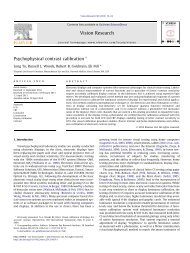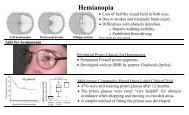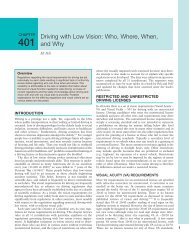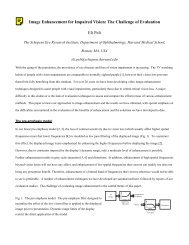In-the-Spectacle-Lens Telescopic Device for Low Vision
In-the-Spectacle-Lens Telescopic Device for Low Vision
In-the-Spectacle-Lens Telescopic Device for Low Vision
Create successful ePaper yourself
Turn your PDF publications into a flip-book with our unique Google optimized e-Paper software.
wearer an unobstructed, non-magnified view of <strong>the</strong> environment through <strong>the</strong> carrier lens at <strong>the</strong>same time as a magnified image (through <strong>the</strong> telescope) that is translated vertically, enabling anopen, wide horizontal FOV including that of objects seen through <strong>the</strong> telescope. The magnifiedimage could be shifted in o<strong>the</strong>r directions, but shifting <strong>the</strong> magnified image above <strong>the</strong>unmagnified view is preferable because <strong>the</strong> magnified image occupies an area of <strong>the</strong> visual fieldthat is less likely to include obstacles or o<strong>the</strong>r mobility relevant objects. The in-<strong>the</strong>-lens telescopedesign facilitates Simulvision, in part, because <strong>the</strong>re is no opaque frame or mounting structure toblock <strong>the</strong> unmagnified view.The optical elements that act as objective and ocular lenses can be conventional meniscuslenses attached to <strong>the</strong> carrier lens as shown in Figs. 3 and 4. However, those lenses could bereplaced with curved mirrors, Fresnel lenses, diffractive lenses, or holographic elements. Theseo<strong>the</strong>r elements have a durability advantage as <strong>the</strong>y can be embedded within <strong>the</strong> carrier lens.Curved mirrors also offer several o<strong>the</strong>r important benefits: mirrors are free of chromaticaberration; <strong>the</strong>y yield more optical power with <strong>the</strong> same curvature when compared with planoconvexlenses (thus reducing <strong>the</strong> dimension requirements <strong>for</strong> <strong>the</strong> carrier lens); and <strong>the</strong> distancebetween mirrors needed to create an afocal optical system does not depend on <strong>the</strong> refractiveindex of <strong>the</strong> carrier lens, but only on <strong>the</strong>ir focal lengths.2.3. Keplerian prototype with laminated lenses<strong>In</strong> a first prototype we implemented <strong>the</strong> generic design described in section 2.2 (shown inFig. 4). The lower image erecting mirrors were made by cutting an ophthalmic lens blank and<strong>the</strong> periscopic mirrors were created using small prisms. All mirroring was achieved in this designthrough total internal reflection, as shown in Fig. 5.12
















